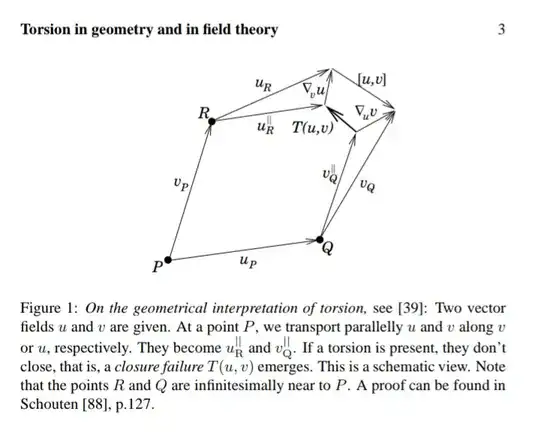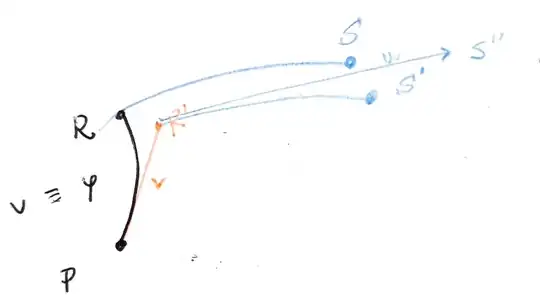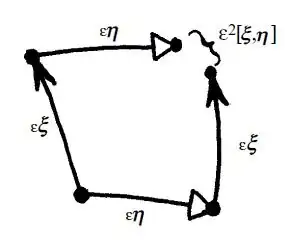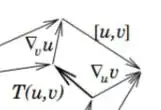I have seen this kind of picture a lot, linking the Lie Bracket with the Torsion (e.g. 1, 2, 3, 4).
I will report for convenience one of such picture, from Hehl and Obukhov review article
For some reason I am not able to understand how the Lie Bracket can be seen in that way. I will say what I have done so far, I would be glad if someone would point me to the missing piece or maybe if I am misunderstanding the approximation done.
Let us take two vector fields $u$ and $v$ on a manifold $M$. Choose a $P\in M$, we can say that $$ u_P = u^k \left( \frac{\partial}{\partial x^k} \right)_P $$ $$ v_P = v^k \left( \frac{\partial}{\partial x^k} \right)_P $$
Let me say with abuse of notation that $R=P+\epsilon v$ and $Q=P+\epsilon u$ (I believe the formal way would be to go down in the chart and then coming back with the inverse). Anyway $u$ in $R$ is $$ u_R \approx \left( u^k +\epsilon v^i \frac{\partial u^k}{\partial x^i} \right) \left( \frac{\partial}{\partial x^k} \right)_R \approx \left( u^k + \epsilon v^i \frac{\partial u^k}{\partial x^i} + \epsilon v^i u^j \Gamma_{ij}^k + O(\epsilon^2)\right) \left( \frac{\partial}{\partial x^k} \right)_P $$ while the parallel transport of $u$ along $v$ $$ u_R^{//} \approx \left( u^k - \epsilon \Gamma_{ij}^k v^i u^j \right) \left( \frac{\partial}{\partial x^k} \right)_R \approx \left( u^k + O(\epsilon^2) \right) \left( \frac{\partial}{\partial x^k} \right)_P $$ Which I reported in the tangent space of $P$, using the fact that \begin{equation} \left( \frac{\partial}{\partial x^k} \right)_R = \left( \frac{\partial}{\partial x^k} \right)_P + \epsilon v^i \Gamma_{ik}^j \left( \frac{\partial}{\partial x^j} \right)_P \end{equation} Now that my vectors all belong to the same tangent space $T_P M$ I can finally verify $$ u_R - u_R^{//} = \nabla_{v} u $$ If I want to get the Lie Bracket from the drawing, I can calculate the vectors $u_R$ and $v_Q$, report them in $P$ and combine them accordingly, i.e. \begin{equation} \begin{split} (u_P + v_Q) - (v_P + u_R) &= u^k + v^k + \epsilon v^i u^j \Gamma_{ij}^k + \epsilon v^i \frac{\partial u^k}{\partial x^i} - \left( u^k + v^k + \epsilon u^i v^j \Gamma_{ij}^k + \epsilon u^i \frac{\partial v^k}{\partial x^i} \right) \\ &= \epsilon v^i u^j T_{ij}^k - \epsilon [u,v] \end{split} \end{equation} So also the torsion appears to me in that subtraction, and that is why I cannot understand that picture... What am I missing? It seems to me that I should not report the vectors back in P, but then how can I add or subtract vectors in different tangent spaces?
And once this is solved, what is the connection of the Lie Bracket with the Torsion, could anybody shine light on this?



